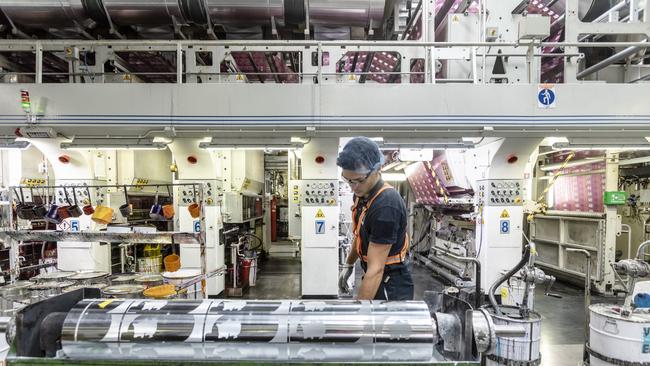Amcor bets the worst is behind it and posts a 5pc lift in dividends to Australian security holders
The world’s biggest packaging company has cut costs, lifted its dividend and reiterated its full-year profit guidance.

The world’s biggest packaging company, Amcor, is banking on continued improvements in global sales and ongoing cost cutting programs to maintain its full-year profit forecast.
Its quest is on the back of flagging sales and margins in the first half brought on by soft market conditions in healthcare and beverages, and a general trend for companies to run down their existing supplies of packaging.
Amcor chief executive Ron Delia said “December was the low point,” and on Wednesday announced a higher-than-expected dividend – of more than 5 per cent in Australia dollar terms – for the dual listed company.
“We have seen volumes improve in January relative to the first half, and we expect the business to build momentum in the second half, including delivering mid single-digit adjusted earnings growth in the fiscal fourth quarter,” Mr Delia said.

Amcor reaffirmed its full-year guidance of earnings per share of between US67c and US71c a share, and announced an increased quarterly dividend of US12.5c per share – up from US12.25c in the previous corresponding period – for US stock, and an unfranked dividend of 18.98c per share for the ASX-listed securities.
In Australian dollar terms, the second quarter dividend equated to a more than 5 per cent jump on the previous corresponding period, according to Atlas Funds Management chief investment officer Hugh Dive, whose firm’s second-biggest overweight position is Amcor.
The fund manager said the company was benefiting, at least from a dividend perspective, from the weak Australian dollar.
“We like the quarterly dividend,” Mr Dive said. “It’s a relatively stable company, a good blue chip, and it looks pretty cheap compared to the rest of the market.”
Amcor operates 218 packaging manufacturing factories in 41 countries, and is considered a litmus test for the strength of the global economy, as its packaging is used in most consumer goods – from coffee and meat packs to pharmaceuticals and tobacco.
Interim net sales fell 9 per cent to $US6.69bn. On a constant currency basis, sales were 8 per cent lower than last year, and volumes were approximately 9 per cent lower than last year. Adjusted earnings before interest and tax fell 6 per cent to $US709m on a comparable constant currency basis.
Mr Delia said Amcor had responded to ongoing weakness in demand by “taking actions to further reduce costs,” and locked in a $US200m reduction in expenses by retrenching 1000 workers during the first half. None of the cuts were in Australia, and were predominantly from Europe and the US.
The cuts came on top of 1000 workers losing their jobs in the previous half, and the combined number equated to about 5 per cent of Amcor’s workforce.
“Confidence in our earnings outlook is based on known second-half benefits related to the elimination of earnings headwinds from the sale of our Russia business, a lower interest expense headwind, and our structural cost reduction and productivity initiatives,” Mr Delia said.
The Zurich-headquartered company sold its three plants in Russia for $US365m and took a $US200m writedown on the sales after the country invaded Ukraine.
Mr Dive said Amcor’s decision to exit Russia had paid off and reflected continued solid management of the packaging giant.

“In hindsight, that was an excellent deal,” Mr Dive said. “Those that stayed have got zero for their assets, so it proved to be very smart to go first there.”
As for how the company will find growth after relying on extensive cost-cutting in the previous period, Mr Dive said that Amcor invested in research and development for reusable and recycled products.
“The likes of Nestle demand more recycled and high-tech packaging, and consumers and manufacturers are willing to pay up for that, so they will continue to grow over time as people become more aware, and they capture more market share,” he said.
While Mr Dive was happy with the half-year result, Barrenjoey analyst Brook Campbell-Crawford pointed out that the company benefited from only paying a 16 per cent tax rate in the second quarter and that it missed its targets in both flexible and rigid products.
Barrenjoey retained its “underweight” rating for Amcor but noted the company’s efforts on costs.
“The EPS beat was driven by non-operational items, with AMC reporting lower corporate costs, lower interest expense, and lower tax than market expectations,” Mr Campbell-Crawford wrote in a “quick take” note to clients.
Barrenjoey also pointed to the company’s high gearing.
Net debt was $6.64bn by the end of the half, with leverage of 3.4 times. The company said it expected leverage to “return to approximately 3 times at June 30, 2024”.
Still, Mr Campbell-Crawford agreed that as a dividend play, Amcor was undoubtedly attractive.
“It’s a 1 to 2 cent increase per year … and a 72 per cent payout ratio,” Mr Campbell-Crawford told The Australian. “If you care about a dividend, it’s unlikely to be cut, so you could own it for that reason.”






To join the conversation, please log in. Don't have an account? Register
Join the conversation, you are commenting as Logout